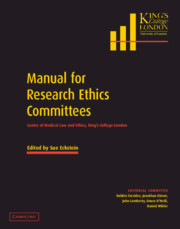Book contents
- Frontmatter
- Contents
- Editorial board
- Acknowledgements
- List of contributors
- Introduction
- Part I
- 1 The ethics of clinical research
- 2 Research ethics committees and the law
- 3 The regulation of medical research: a historical overview
- 4 The regulation of medical research in the UK
- 5 Observational and epidemiological research
- 6 Social survey research
- 7 Approaching qualitative research
- 8 Complementary and alternative medicine: challenges for research ethics committees
- 9 The ethical review of student research in the context of the governance arrangements for research ethics committees
- 10 The ethics of genetic research
- 11 Research or audit?
- 12 Randomised controlled trials
- 13 Determining the study size
- 14 Risk assessment for research participants
- 15 Absorbed radiation in patient and volunteer studies submitted to the ethical committee: a memorandum
- 16 A guide to the use of radioactive materials and radiological procedures for research purposes
- 17 Indemnity in medical research
- 18 The prevention and management of fraud and misconduct: the role of the LREC
- 19 Understanding clinical trials: a model for providing information to potential participants
- 20 The law relating to consent
- 21 Writing information for potential research participants
- 22 The law relating to confidentiality
- 23 Research involving vulnerable participants: some ethical issues
- 24 The ethics of research related to healthcare in developing countries
- Part II
- Index
15 - Absorbed radiation in patient and volunteer studies submitted to the ethical committee: a memorandum
Published online by Cambridge University Press: 08 January 2010
- Frontmatter
- Contents
- Editorial board
- Acknowledgements
- List of contributors
- Introduction
- Part I
- 1 The ethics of clinical research
- 2 Research ethics committees and the law
- 3 The regulation of medical research: a historical overview
- 4 The regulation of medical research in the UK
- 5 Observational and epidemiological research
- 6 Social survey research
- 7 Approaching qualitative research
- 8 Complementary and alternative medicine: challenges for research ethics committees
- 9 The ethical review of student research in the context of the governance arrangements for research ethics committees
- 10 The ethics of genetic research
- 11 Research or audit?
- 12 Randomised controlled trials
- 13 Determining the study size
- 14 Risk assessment for research participants
- 15 Absorbed radiation in patient and volunteer studies submitted to the ethical committee: a memorandum
- 16 A guide to the use of radioactive materials and radiological procedures for research purposes
- 17 Indemnity in medical research
- 18 The prevention and management of fraud and misconduct: the role of the LREC
- 19 Understanding clinical trials: a model for providing information to potential participants
- 20 The law relating to consent
- 21 Writing information for potential research participants
- 22 The law relating to confidentiality
- 23 Research involving vulnerable participants: some ethical issues
- 24 The ethics of research related to healthcare in developing countries
- Part II
- Index
Summary
Introduction
Radiation is a natural phenomenon.
The current method of measuring absorbed radiation is the effective dose equivalent in units called millisieverts, mSv. This allows different types of radiation from different sources, X-rays, gamma rays, cosmic rays, etc. to be compared. Normal exposure in London is about 0.18 mSv per month including that from cosmic rays and natural radioactive potassium and radon in our bodies. The computed risk of death from 0.1 mSv is one in a million, which is the same risk as smoking one and a half cigarettes in a lifetime or drinking half a litre of wine in a lifetime or, indeed, the risk of death for a man aged 42 living for a day or a man aged 60 living 20 minutes.
Perception of risk
The popular perception of radiation risk is much greater than in fact it is. Studies in the USA of League of Women Voters and college students put the risk of nuclear power first and business and professional club members put the risk at eighth of a list of 30 agents, whereas in fact it was 20th (the risk was 1500 times less than average cigarette smoking, 1000 times less than average alcohol consumption, 500 times less than motor vehicle driving, 30 times less than swimming and 10 times less than bicycling). The lifespan shortening on a population basis associated with medical X-ray is 6 days, of which the nuclear medicine contribution is 4 hours as compared with natural background radiation 8 days; accidents in the home 95 days; accidents at work 74 days; and heart disease 2100 days as examples.
- Type
- Chapter
- Information
- Manual for Research Ethics CommitteesCentre of Medical Law and Ethics, King's College London, pp. 69 - 71Publisher: Cambridge University PressPrint publication year: 2003



